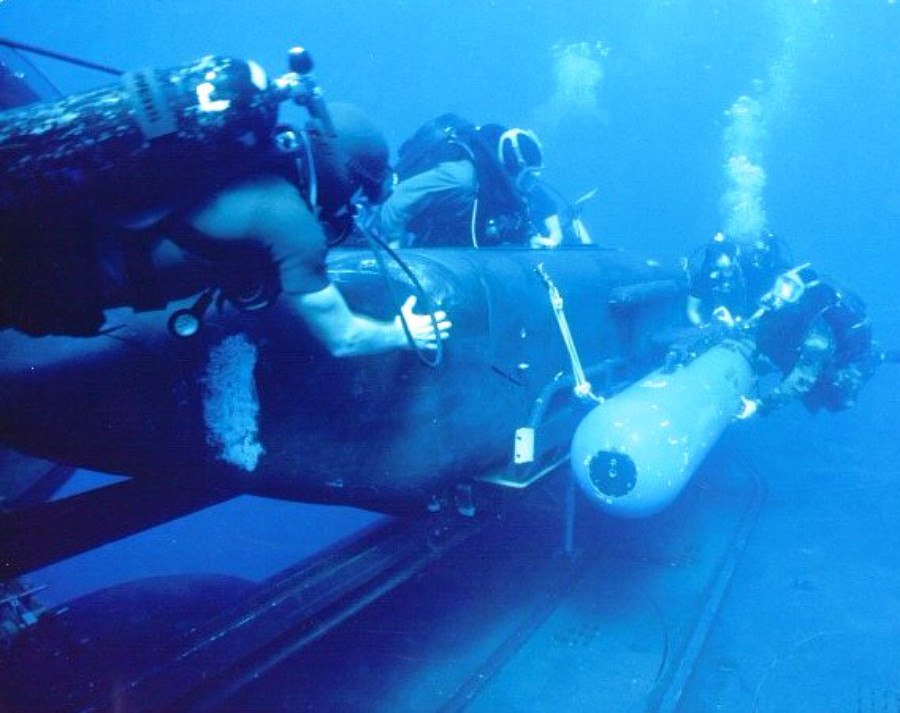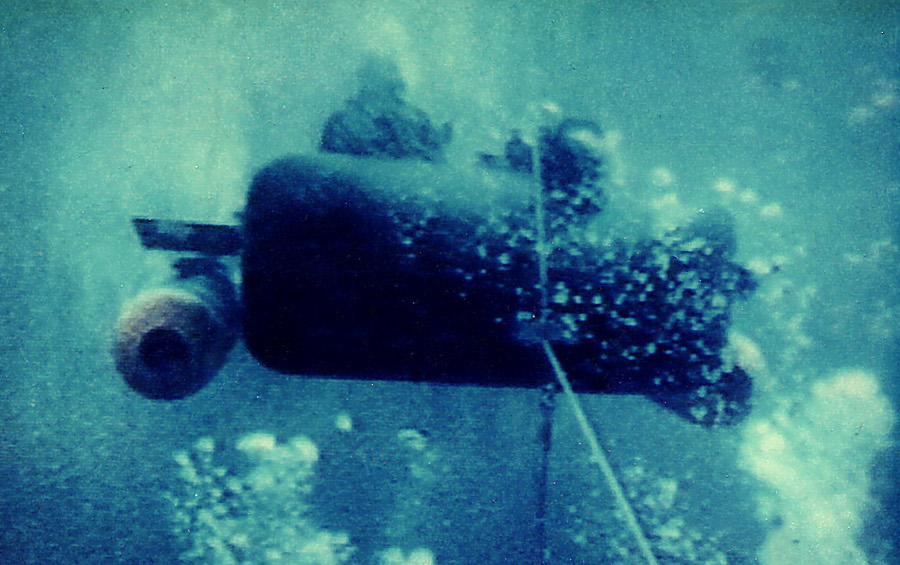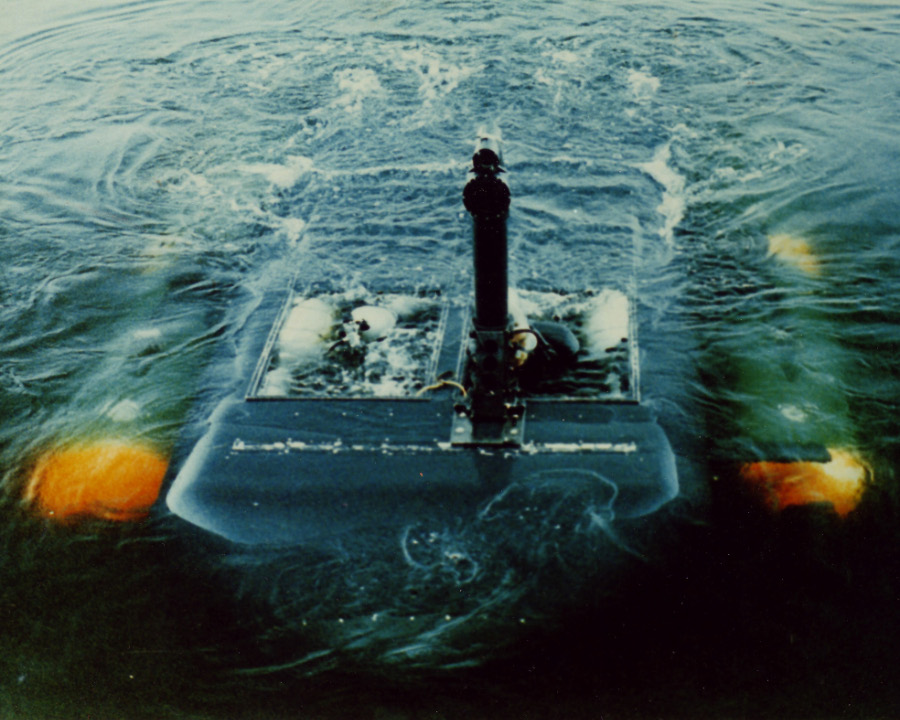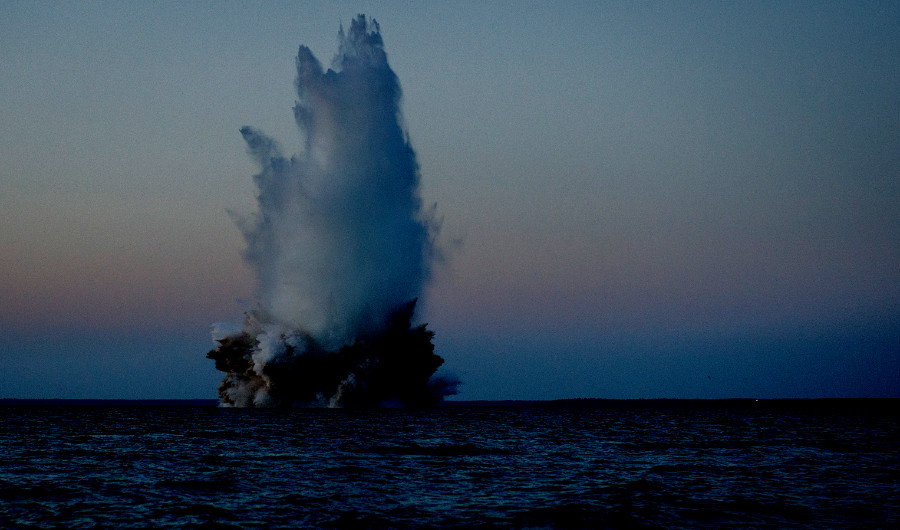US Navy SEAL's torpedo armed mini-sub 

 The SDV Mk.9 is unique among the US Navy SEALs submersibles because it could be armed with two heavyweight torpedoes. The type’s existence is well known within the Special Forces community (and among some observers), but very little specific information has reached the public. Most SEAL related books gloss over the covert world of SDVs.
The SDV Mk.9 is unique among the US Navy SEALs submersibles because it could be armed with two heavyweight torpedoes. The type’s existence is well known within the Special Forces community (and among some observers), but very little specific information has reached the public. Most SEAL related books gloss over the covert world of SDVs.
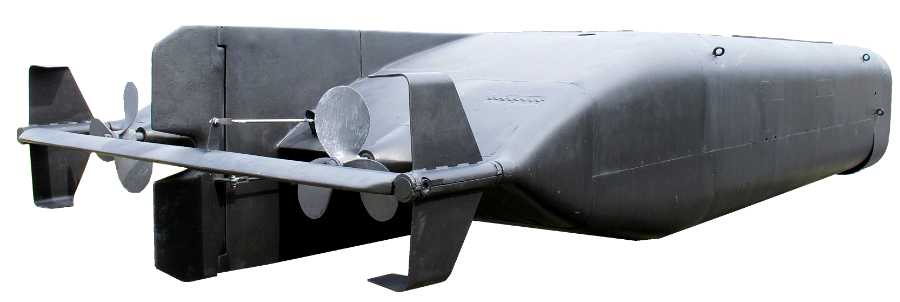
The torpedoes were known as the Stand-off Weapon Assembly (SWA) and were in fact modified Mk.37 torpedoes. The Mk.37 had entered service in the 1950s as the US Navy’s primary submarine-to-submarine weapon, but was being replaced by the newer Mk.48 in the 1970s. Consequently a stockpile of serviceable Mk.37s was readily available for the SEALs for conversion into short ranged line-of-sight torpedoes.
In the submarine hangar the external SWA launch arms (known as the Swing Arm Assembly) were swung upwards so that the torpedoes lay on the top of the craft. This meant that the SWA could not be carried by the larger SDV Mk.8 because it could not fit inside the host submarine's hangar with the weapons (although Mk.37 sized payloads have been carried by the Mk.8 in trials). Consequently the Mk.9 was the only SDV equipped with this weapon system.
Original artwork - CLICK for HIGH-RESOLUTION image. 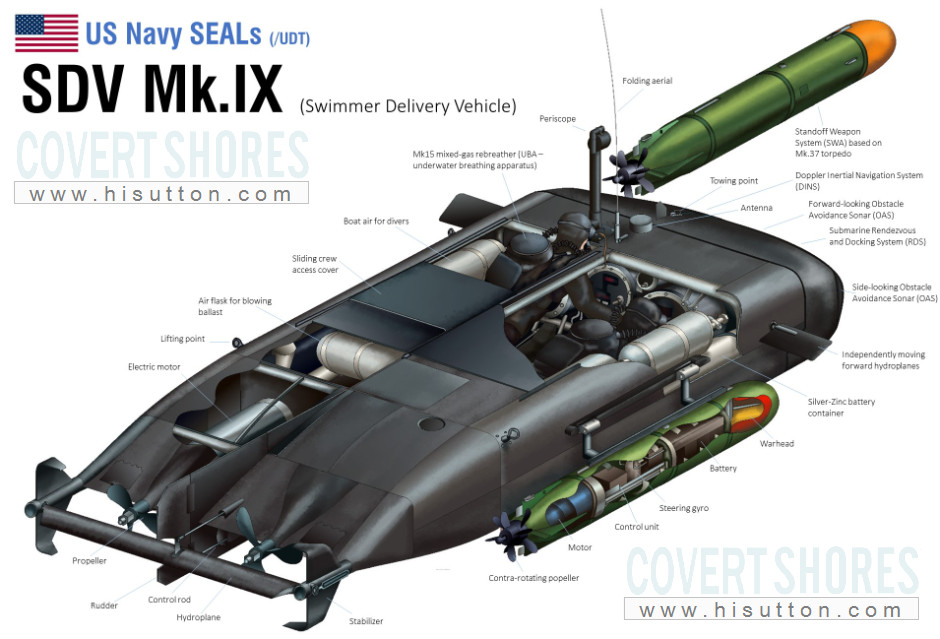
As well as the SWA, the Mk.9 could carry two Limpet Assemble Modular (LAM) Mk.5 MOD 0 large anti-ship limpet mines in place of the torpedoes. This configuration was nicknamed Little Bo Peep for obvious reasons, but was never progressed to an operational capability. Satchel charges and smaller limpet mines could be carried in the payload bay behind the divers' feet as they lay prone.
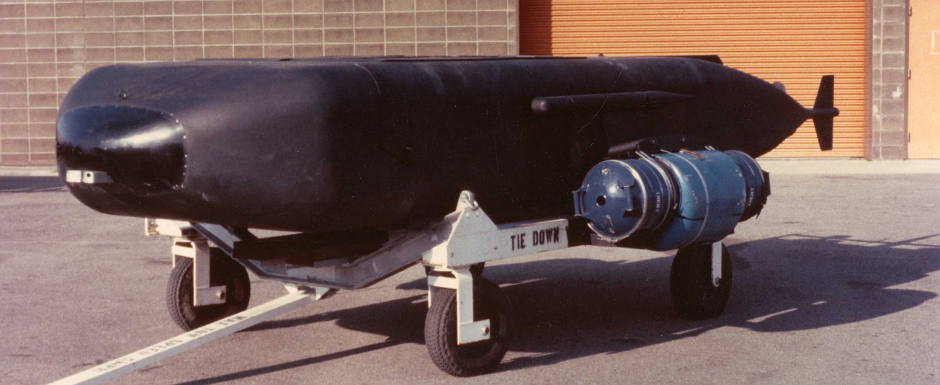
*"Little Bo Peep" with a LAM-5 mine attached to the Swing Arm Assembly. Thanks to CDR Tom Hawkins.
Cruiser killer
The following text is a shortened extract from Covert Shores – the Story of Naval Special Forces Missions and Mini-subs. It is a strictly hypothetical scenario to illustrate the mission profile developed for the SDV Mk.9. The version in the book covers more operational details:
Even with the highly trained DDS (Dry Deck Shelter) teams launching and recovering the SDV will take hours of difficult and methodical work. Everything has to be done per the drill, with no adrenaline fueled shortcuts which might endanger the SEALs, and the crew or the host submarine. A single Mk.IX SDV has been loaded into the Dry Deck Shelter (DDS) of the submarine. It sits on top of its loading cradle with two SWA (Stand-off Weapon Assembly) torpedoes mounted on racks above it. This leaves just enough room to crawl between them to access the crew area of the SDV via the sliding canopy on top. The whole arrangement is very cramped but the experienced DDS crew can get to everything they need, and perform most tasks whether the shelter is flooded or dry. The batteries and motors of the SDV have been checked and everything is ready to go.
About twenty miles from the target the submarine slows to a steady crawl and rises up to within 30ft (9m) of the surface.
//
It is already dark outside and the chances of visual detection of any bubbles released during the launch evolution are minimal. Inside the submarine and DDS the lights have been turned to red to aid night-vision. The DDS team personnel man the shelter and start preparing the boat. Slowly the shelter is flooded and the torpedoes transferred from their brackets onto the swing-arm mountings of the SDV.
//
Checks are made and the SDV emerges aft-first from the DDS. Once outside the forward hydroplanes are attached and tested and the craft is readied for release from its cradle. The torpedoes are swung down over each side and locked into their carry and firing position. Only now do the SEAL mission crew lock out, having waited as long as possible in the comfort of the submarine.
Divers of the Deck crew prepare an SWA armed SDV Mk.9 for launch. Thanks to CDR Tom Hawkins.//
Swimming aft over the top of the SDV they slip inside and adopt a prone position with the pilot on the port (left) side and navigator to starboard. With further checks and constant communication the SDV is finally released. It slowly parts from the submarine, rising to the surface before suddenly diving again. The crew take a few minutes of rising and diving to catch perfect trim, a task made harder by the high agility of the 9-boat. The release happened about thirty minutes after the DDS was flooded, and it takes several minutes more before the SDV is truly on its way to the target. Proceeding at 7-8kt the SDV is at least twice as fast as the earlier generations of wet-submersibles but rather than using this speed to reduce mission times, it is instead translated into much longer transits as a way of keeping the host submarine safer. In the dark confines of the SDV the crew have to constantly monitor their instruments.
SDV Mk.9 with SWA lifts off into the slipstream of the host submarine. The hawser (nautical term for rope) is attached to a buoy and will help the SDV return to the host submarine if there are problems achieving trim or with final checks. This is a video capture of an East Coast UDT-22 crew launching from USS Cavalla out of Hawaii during the first Dry Deck Shelter (DDS) tests. Thanks to CDR Tom Hawkins.//
The SEAL’s necks are already aching due to having to lay with their head upright to read the displays in front of their faces, and the bulky Mk.15 mixed-gas UBA on their backs pushing down doesn’t make it any easier. The water is nearly freezing and the whole mission feels like an ordeal, but this close to the enemy the adrenaline is flowing which takes some of the aches away.
//
The Soviet ships finally come into view through the periscope. They are not easy to see, dark shapes against an equally dark backdrop of sparse rocks and forested shores. Soviet warships have a distinctive appearance and the pilot soon identifies their primary target. The SWA torpedo is a basic straight-running weapon which needs to be fired at around one mile from the target, which is point-blank in submarine terms. The SDV crew know that the moment they launch a torpedo all hell could break loose. The Soviet ships have heavyweight anti-submarine torpedoes and a nuclear depth-charge carrying missile which threatens the host submarine, and her escorts may have smaller anti-submarine rocket launchers which can drop depth charges with sufficient accuracy to obliterate the SDV within moments of detection. Lining up the target through the periscope, they wait for the torpedo’s internal gyroscopes to stabilize before launching both SWA torpedoes in quick succession from just 5ft (1.5m) depth. After 750 yards (0.7km) the torpedoes arm their warheads.
An SDV Mk.9 uses its periscope to aim the SWA. This is a daylight training shot. Thanks to CDR Tom Hawkins.//
The SDV dives slightly as crew use her high agility to turn around and head away in the opposite direction. The idea is to put as much distance between them and the target as possible before impact, but with the craft only capable of 8kt and the torpedoes tearing towards oblivion at about 20kt they are going to be lucky to add a quarter of a mile to their lead. As well as trying to plot a very exact course, the navigator is watching the clock very carefully, counting down to anticipated impact. In a precarious maneuver the SDV must surface moments before impact so that the crew can get themselves out of the water before the explosions. Each AWS’ warhead has 330lb (150kg) of high-blast explosive (HBX) which can produce shockwaves that could seriously injure the swimmers if their body cavities (lungs, ears) were in the water as it reaches the SDV. At least the surfaced SDV gives the men the opportunity to watch with deep satisfaction as the torpedoes hit their target. They can only hope that the Soviets are taken by surprise and that they miss-identify the threat and search in the wrong place. The submariners will be hoping the same thing, being barely twenty or thirty miles from the Soviet anti-submarine ships.
The SWA mission had a mixed review among the SEALs.
Learn EVERYTHING about Special Forces subsCovert Shores 2nd Edition. A world history of naval Special Forces, their missions and their specialist vehicles. SEALs, SBS, COMSUBIN, Sh-13, Spetsnaz, Kampfschwimmers, Commando Hubert, 4RR and many more.
Check it out on Amazon
History
Design of the SDV Mk.9 started in the late 1960s when Aerojet was awarded a contract to develop the next generation SDVs (Swimmer Delivery Vehicles) for the US Navy SEALs and UDTs (Underwater Demolition Teams). Aerojet beat Rockwell, who had built some small submarines, and Convair who’d built the then current main SDV, the Mk.7. Aerojet had been pioneers of SDVs in America but most SDVs used by the SEALs/UDT up to that time had actually been designed in Italy and France. American SDVs of the 1950s and early 1960s had always been experimental, unsuccessful or at best only built in small numbers. The first major American design had been the four-man Convair Model-14 which entered service as the SDV Mk.7. This had actually been heavily influenced by the Italian Cos.Mo.S TRAS design, and was seen as temporary. It was however used operationally in Vietnam, and would be the backbone of the SDV platoons until the new craft came online in the late-1970s. All the same the next generation was already being developed.
The contract called for two designs; a six-man craft to function as a transport (the SDV Mk.8) and a two-man craft for reconnaissance and attack missions (the Mk.9). In the early 1970s Aerojet struggled to deliver to the requirements and development shifted to the US Navy. About this time development of the 9-boat was deprioritized against the Mk.8 and it did not really enter service until the early 1980s (sources vary on dates).
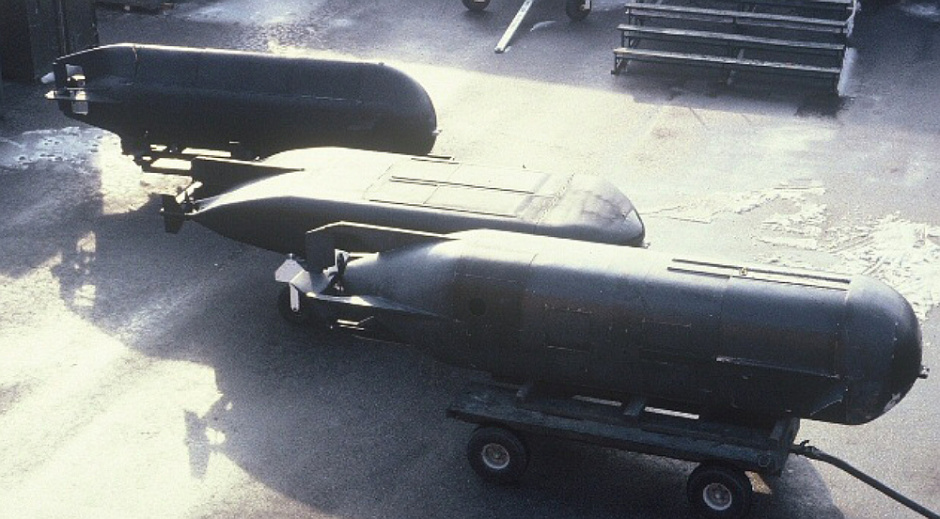
The main three SDVs used by the US Navy SEALs from 1970s-90s. In the background is a late-model SDV Mk.7 which carried four men. In the middle is an early example of the SDV Mk.9, and in the foreground is an early SDV Mk.8 which carried 6 UDT / SEALs. Thanks to CDR Tom Hawkins.
Design
The unusual side-by-side layout with the divers laying prone was likely an Aerojet feature, carried over from the experimental Aerojet Mk.VII. Many earlier two-man SDVs had used a tandem layout to minimize drag but this made crew coordination much more difficult, especially as the new design would have significantly better navigation systems. This required the crew tasking to be split between a pilot and a navigator so communication was vital and the side by side layout helped.
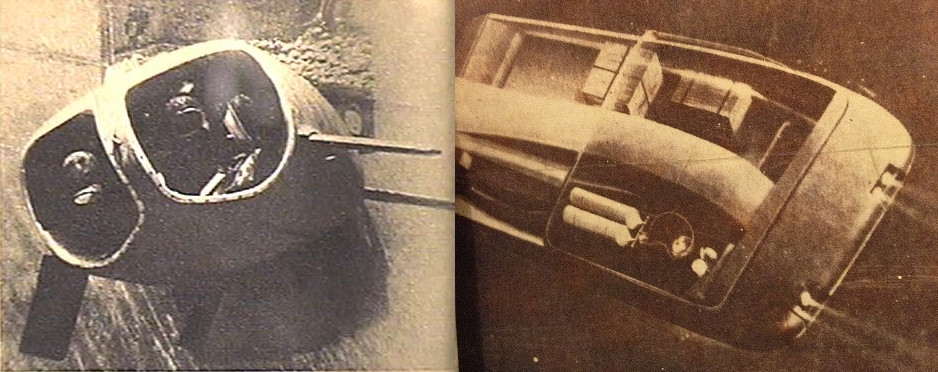
The Aerojet Mk.VII (left) was likely an influence. Other designers were also considering a side-by-side prone layout, such as this 1964 'Underwater Car' concept from the Detroit Testing Laboratory (right).
The side-by-side arrangement allowed the instrument panels to be identical to the SDV Mk.8, simplifying training and maintenance, and potentially allowing crew to remain current on both types simultaneously. Navigation aids included a Doppler Inertial Navigation System (DINS), forward-looking obstacle avoidance sonar (OAS) and side-looking OAS. A submarine Rendezvous and Docking System (RDS) was fitted to help the SDV find the host submarine when returning from a mission.
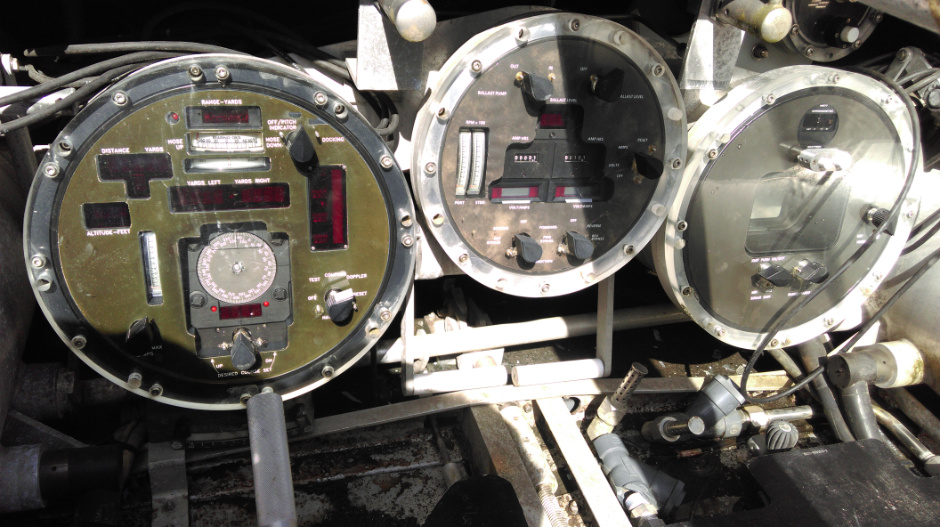
The SDV Mk.9 shared the same instrument configuration as the Mk.8. Photos by S Finnegan (Submarine Forces Library & Museum, Groton, CT)

The sleek low-profile layout helped it operate undetected in extremely shallow water, and contributed to excellent agility. The hydroplanes on most other SDVs moved as one but on the Mk.9 they were independent of each other allowing one to be point upwards, and the other down. This would have been a serious problem in earlier SDVs were instability equated to poor navigation and missing your target, but the DINS allowed accurate route planning. The agility did come at a price however and the craft had the tendency to dive if the pilot did not hold it steady. And the prone crew position, with a Mk.15 rebreather pressing down on your back and your face mask pressed up against the instrument panel to be able to read them, was uncomfortable for long journeys. All the same the SDV Mk.9 was popular with some crew who considered it the sports Porsche of the SDV world because it could dive, turn and roll in underwater acrobatics, and was very fast compared to other craft of its generation.
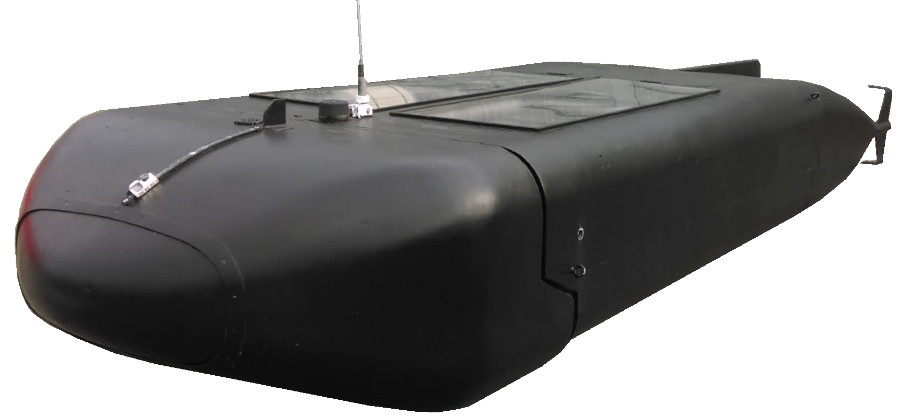
The SDV had two electric motors positioned quite far apart. These were powered by rechargeable silver-zinc batteries which were more expensive and higher maintenance than typical lead-acid batteries, but offered better performance and endurance. In early production boats the electric motors were complemented by a drop-down outboard-prop powered by a propane engine. This offered greater endurance while running on the surface but was dropped in service.
SDV Teams
Although the Mk.9 was intended for both the UDTs and SEAL Teams, in practice only the UDT teams had them operationally (the same goes for the later SDV Mk.7 and SDV Mk.8 boats). This was because of the SEAL teams could never afford the training investment required to achieve and maintain readiness on SDVs. Additionally, SDV operations were not for everybody - many SEALs were cured of wanting any part of underwater operations during their selection (BUD/S). SDV platoons and crews thus became a small and exclusive group within the wider UDT and SEAL community. By the early 1980s SDV skills were concentrated in UDT 22 on the East Coast and UDT-12 on the West Coast.
In May 1983, the UDTs were redesignated as SEAL Teams with two becoming dedicated SDV Teams, one for each coast (UDT-12 became SDVT-1 and UDT-22 became SDVT-2). The SDV teams were SEAL trained and operated both the Mk.8 transport and the Mk.9 attack boat. Each SDVT had up to five SDV platoons each of two officers and 12 enlisted men, and 1-3 SDVs. There were additionally two dedicated DDS platoons (see below) per SDVT. DA missions could be specific to the SDV Team, or in conjunction with other SEAL Teams.
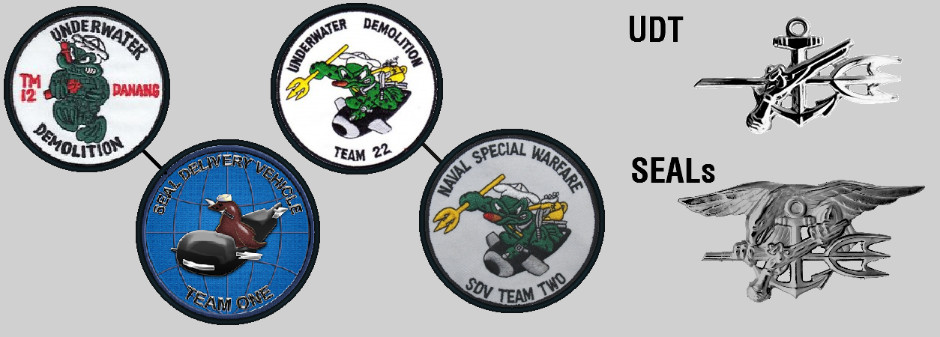
Getting within range of the target
SDVs by their nature are short ranged craft. The batteries and the crew, who are exposed to the water around them, limit the endurance to about 12 hours (generally less!). They therefore need a larger submarine or surface craft to get them within range of the enemy. This is an aspect where the US Navy has always excelled, at least in relative terms.
The Mk.9 was designed from the outset to fit into the same submarine hangars as the Mk.8, allowing near-equal deployability. Its dimensions were defined by the size of the Regulus missile hangars on the converted transport submarine USS Grayback (USS Growler was also slated for conversion to an SDV host submarine but this was cancelled due to cost overruns). The Mk.9 was wider than the Mk.8 so it was a snug fit inside the hangar, but operators could climb or swim over the top of it. The torpedo assemblies (see below) had to be swung upwards to fit inside the hangar with the torpedoes laying on top of the craft.
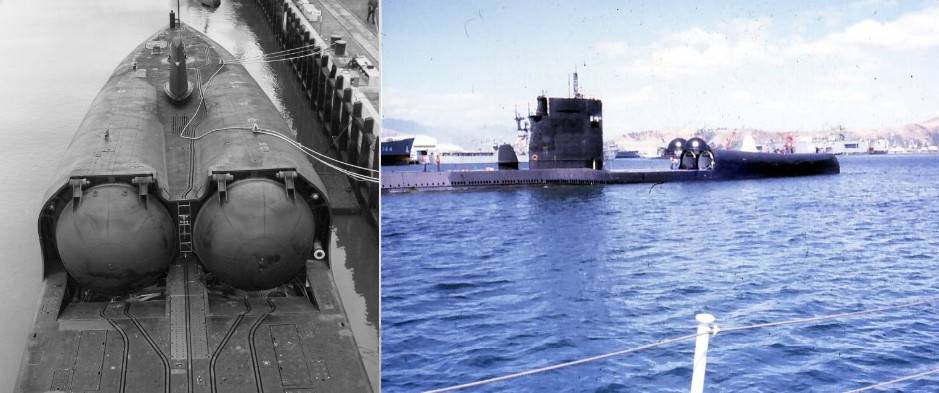
The twin hangars on USS Grayback were located in a raised bow section of the boat with the hatches opening onto the forward deck. Right-hand photo courtesy of the RAN Clearance Divers Association (http://www.rancd-association.com)
After the retirement of Grayback, the host submarine capability was handed over to specially modified nuclear attack submarines using bolt-on external Dry Deck Shelters (DDS). A fleet of eight DDS compatible boats was maintained with two converted ballistic missile submarine (SSBN) capable of carrying two DDS (so up to two SDVs of either Mk.8 or Mk.9) and 60+ SEALs, and six less capable single-DDS compatible attack submarines. The fleet was divided equally between the two coasts, which was a major boost for the East Coast SEAL teams who had been denied a proper SDV host submarine capability when Growler’s conversion was cancelled.
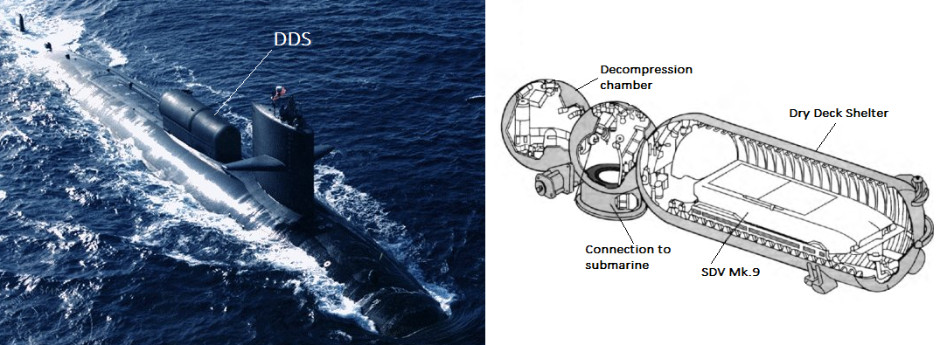
The host submarines were complemented by 3 specially modified 180ft LCUs (landing craft utility) designated as Advanced SEAL Delivery Vessels (ASDV). Outwardly similar to other LCUs and thus inconspicuous, these were virtually unknown but important capability for the SEALs during the 1980s-90s. Each ASDV was equipped with a 25 ton crane capable of lifting an SDV out of the water and a hyperbaric chamber for diver decompression. They operated in support of SEAL/UDT Swimmer Delivery Vehicle operations and training.
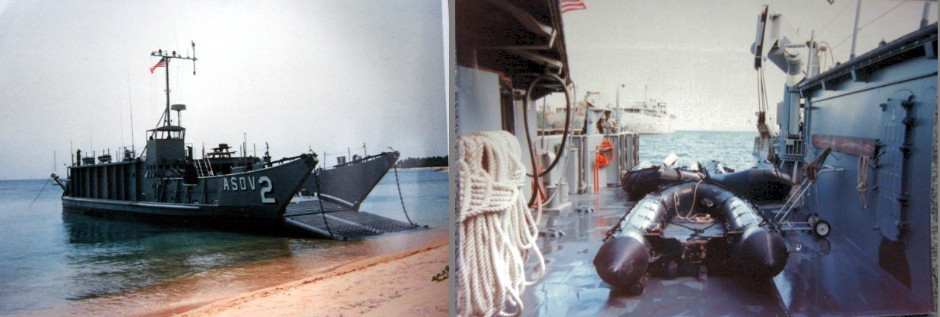
Get The essential guide to World Submarines
This Covert Shores Recognition Guide Covers over 80 classes of submarines including all types currently in service with World Navies.Check it out on Amazon
Phasing out
Although development was successful, the Mk.9 enjoyed a relatively short career and was phased out of frontline service in the 1980s to save manpower for the SDV Mk.8, and was finally retired in the 1990s. Several examples have been preserved:
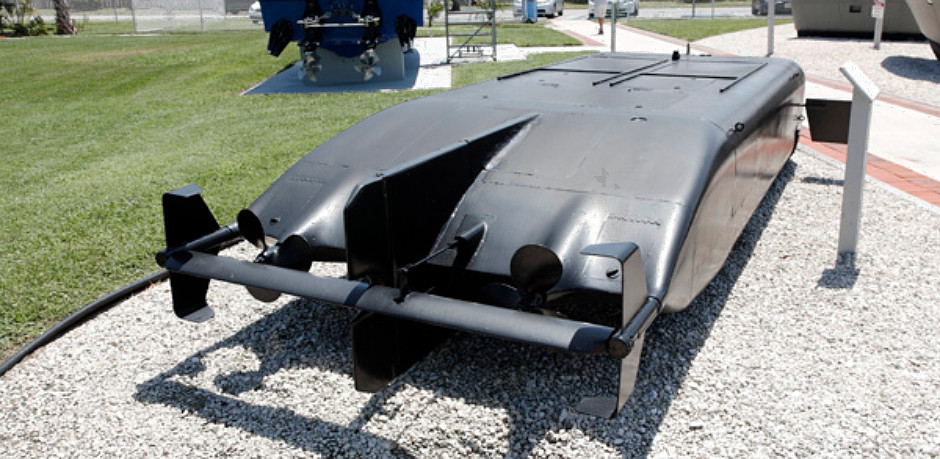
SDV Mk.9 preserved at the Navy SEAL Museum, Ft. Pierce, FL
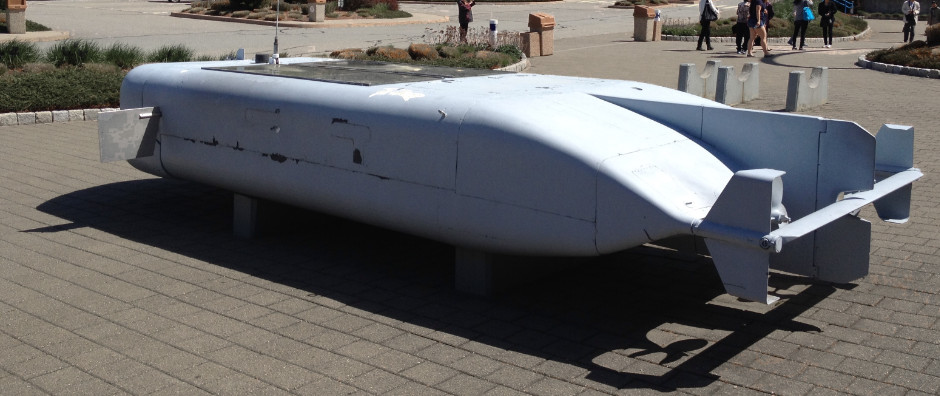
SDV Mk.9 preserved at the Submarine Forces Library & Museum, Groton, CT
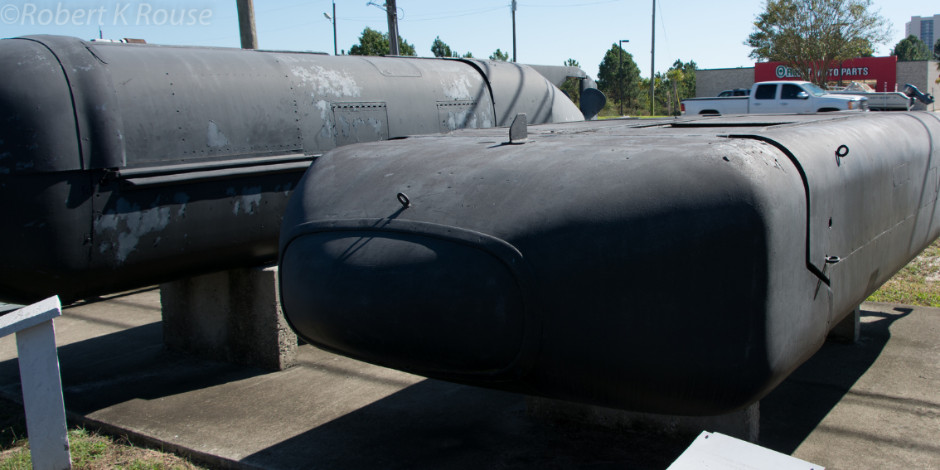
SDV Mk.9 preserved at the Man in the Sea Museum, Panama City, FL. Credit Robert K Rouse
Special Acknowledgements
All articles draw from multiple sources. In particular I have benefited from the knowledge of people who know more than I possibly ever could. Of course any errors are the responsibility of myself alone. I was particularly fortunate to be in contact with the below two former SEAL officers with first-hand experience of the SDV Mk.9. Both are also highly-recommended authors and both are doing their part recording the history of the US Navy SEALs and their SDVs:
CDR Tom Hawkins, SEAL / UDT (Retired)
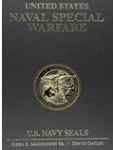
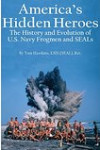
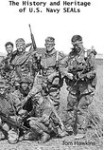
CDR Michael Wood, SEAL / UDT (Retired)
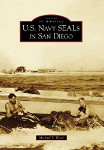
Phojo-Frog blog
Related articles (Full index of popular Covert Shores articles)

 SWSC (Shallow Water Combat Submersible) US Navy SEALs next gen' SDV
SWSC (Shallow Water Combat Submersible) US Navy SEALs next gen' SDV

 Alseamar MURENE SLV
Alseamar MURENE SLV

 Deep Shadow SDV
Deep Shadow SDV

 DGSE's SDVs
DGSE's SDVs

 Wholphin X2, Dolphin X1 and Piranha SDV-X
Wholphin X2, Dolphin X1 and Piranha SDV-X

 Cos.Mo.S CE4F 4-man SDV
Cos.Mo.S CE4F 4-man SDV


 Dry Combat Submersible (DCS)
Dry Combat Submersible (DCS)

 Sphyrene and Coryphene SDVs
Sphyrene and Coryphene SDVs

 Narwal / Orca Dry Combat Submersible (UWTG)
Narwal / Orca Dry Combat Submersible (UWTG)


 USN Navy SEAL's UOES3 (Button 5.60) Dry Combat Submersible (DCS)
USN Navy SEAL's UOES3 (Button 5.60) Dry Combat Submersible (DCS)

 Proteus advanced SDV
Proteus advanced SDV

 Nerpa anti-diver UUV
Nerpa anti-diver UUV

 Naval Spetsnaz in Hybrid Warfare (Russian SDVs and DPVs)
Naval Spetsnaz in Hybrid Warfare (Russian SDVs and DPVs)

 Patriot 3M diver propulsion (Kraken, DAAPV, Jetboots)
Patriot 3M diver propulsion (Kraken, DAAPV, Jetboots)

